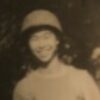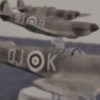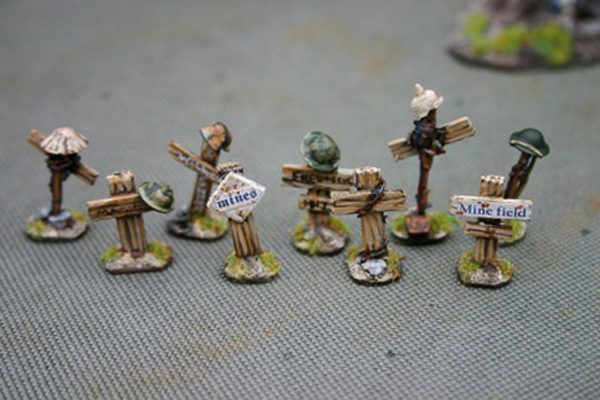WW1 – action near Le Cateau (1918)
Home › Forums › Historical › Bolt Action › WW1 – action near Le Cateau (1918)
- This topic has 40 replies, 5 voices, and was last updated 1 year, 10 months ago by
 Cliff C.
Cliff C.
-
AuthorPosts
-
February 17, 2021 at 7:03 am #184366
Robert
ParticipantHere is the British Vickers MMG team setting up in the top storey of the Crescent Root building. These models are lighter than the resin Total Battle Miniatures but very robust nonetheless.
The 18 pounder has been set up, protected by the British right flank guard.
Robert
Attachments:
February 17, 2021 at 7:15 am #184368Robert
ParticipantA British squad on the left flank, advancing behind the cover of a wall. The men with soft caps are 1914 dismounted British cavalry.
Robert
Attachments:
February 17, 2021 at 5:19 pm #184402Robert
ParticipantThe British 18 pounder fired directly at the building next to the crossroads. The German squad took pins. Here are the markers, at the base of the building.
Robert
Attachments:
February 17, 2021 at 6:32 pm #184404Robert
ParticipantHere is the perspective of the 18 pounder gun crew. A Litko blast marker shows where the HE shell penetrated. The right flank infantry section has gone ‘Down’, no doubt hastened by the overpressure.
Robert
Attachments:
February 18, 2021 at 7:29 am #184409Robert
ParticipantMeanwhile on the German left flank, the sniper team and AT gun came under fire from a British sniper. The German commander had been worried about British tanks or armoured cars, hence deploying the AT gun as left flank protection. The Germans came out on top in this isolated exchange.
Robert
Attachments:
February 18, 2021 at 9:44 pm #184420 Greg SParticipant
Greg SParticipantThose are great minis and photos. I am looking forward to seeing the battle unfold.
February 21, 2021 at 1:40 pm #184460Robert
ParticipantThanks, Greg.
The 18 pounder posed a major threat. It threatened the German-occupied building next to the crossroads. Two British infantry sections were approaching the building from the south. With direct fire support, the two sections stood a better chance of overwhelming the remnants of the German squad in the building. Smoke was called in, targeted to land on the crossroads and block line of sight for the British gunners. The round missed left. A Litko smoke screen billowed onto the spot. The threat had not been neutralised.
Attachments:
February 22, 2021 at 7:48 am #184466Robert
ParticipantWorse was to come. The MG08 team had taken up a position with very limited line of sight. The British commander had positioned his right flank infantry section to protect the 18 pounder field gun. In doing so, however, the infantry section had strayed unwittingly into view of the MG08 team. A sustained burst of fire caught the infantry section in enfilade. Several men went down under a hail of 7.62mm rounds.
Robert
Attachments:
February 22, 2021 at 11:13 am #184470Robert
ParticipantThe British infantry section responded immediately by shifting position but lost any further initiative in that turn. The markers are from Grand Manner.

Robert
Attachments:
February 23, 2021 at 11:21 am #184496Robert
ParticipantAt this point, the British Vickers MG team had managed to set up the machine gun. The NCO pointed to the German 77mm field gun and quickly estimated the range. The gunner squeezed the triggers with both thumbs and a burst of 0.303 bullets landed in a narrow beaten zone. Some ricocheted off the gun shield; most overshot the target. In any event, the field gun survived unscathed. The experienced gunners were unaffected, other than to search out and identify quickly the source of the fire. The photo shows the Vickers MG team silhouetted in the window on the upper floor. This is because the far section of roof had been removed on the model to allow the MG team to be put in place. In practice, the German gunners would not have had this level of help… A 77mm high explosive projectile burst through the window in reply. The MG team had taken a risk to put the field gun out of action. It was the Vickers team that paid the price.
Robert
-
This reply was modified 4 years, 2 months ago by
Robert.
Attachments:
February 23, 2021 at 2:48 pm #184526Robert
ParticipantThe British commander had suffered two quick setbacks at this point. Fortunately, he was able to retain the initiative. The plan was to push the British right flank. With that in mind, the next move saw the Austin armoured car (manufactured by 1st Corps) come onto the table. It pushed along the road, scanning for enemy threats to be engaged by the twin Hotchkiss machine guns.
Robert
Attachments:
February 25, 2021 at 3:50 pm #184552Robert
ParticipantThe Minenwerfer team reacted immediately to the new threat. They traversed the tube and set it to direct fire mode, as illustrated here:

Late-war Minenwerfer were designed to operate this way as an anti-tank measure.
The armoured car took a round through the engine compartment. It ignited a fire but failed to explode. The fire was short-lived but the crew was still suffering from shock.
Robert
-
This reply was modified 4 years, 2 months ago by
Robert.
Attachments:
February 25, 2021 at 8:44 pm #184556Robert
ParticipantAnother view of the stricken Austin armoured car. Fair dues to the crew though. They didn’t bail. Meanwhile, the Granatenwerfer team spotted the British infantry section trying to edge along the stone wall and draw a bead on the two German teams. A high explosive fragmentation bomb landed close by the Brits, inflicting some shock but not the shattering effect that the Granatenwerfer team had hoped for. The explosion and pin markers can be seen top right of the photo.
Robert
-
This reply was modified 4 years, 2 months ago by
Robert.
Attachments:
February 26, 2021 at 9:10 am #184563 invisible officerParticipant
invisible officerParticipantNice battle report. That the Granatwerfer 16 did little damage………
More please.
February 27, 2021 at 11:38 am #184578Robert
ParticipantThe Granatwerfer team was also disappointed (to put it mildly) with the effect too. It seemed to them as if some higher god was just throwing dice… Casting such superstitions to one side, the team set about placing the next round on the spigot. Meanwhile, the German Zugführer (a Leutnant with several years of experience by this stage of the war) took stock of the wider situation. He realised that there was an opportunity to take the initiative at last. The two infantry squads in the farm complex were ordered to debouch from the buildings and storm the British right flank. The left flank squad ran out in an effort to encircle the British infantry and field gun. The other squad was more cautious, moving forward enough to start engaging and hopefully pinning the British infantry section.
Robert
-
This reply was modified 4 years, 1 month ago by
Robert.
-
This reply was modified 4 years, 1 month ago by
Robert.
Attachments:
-
AuthorPosts
- You must be logged in to reply to this topic.














